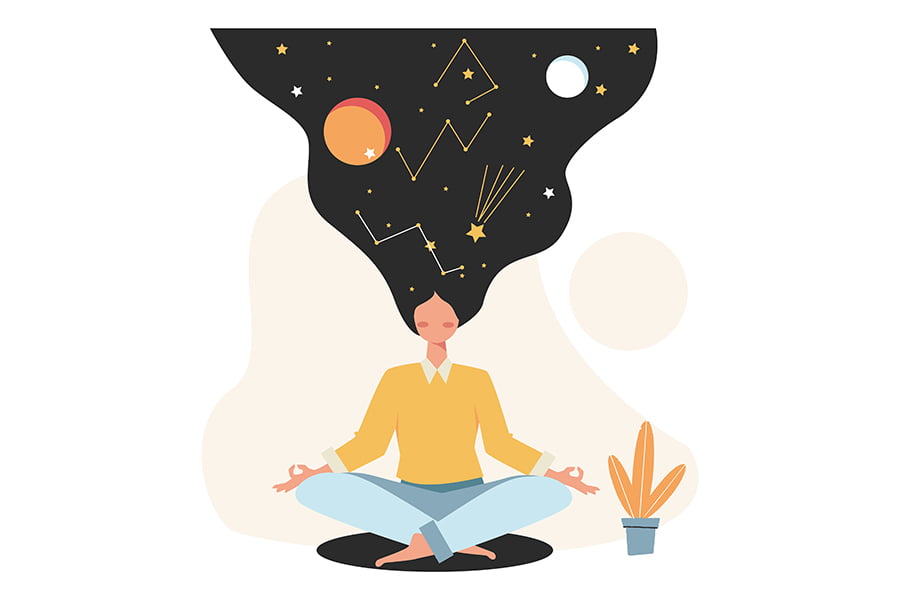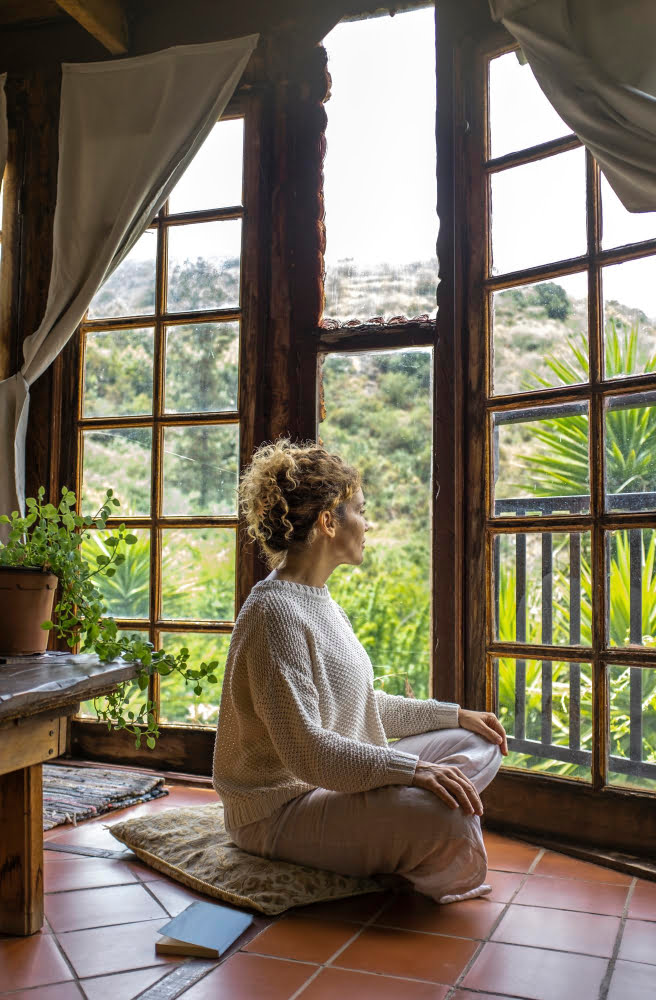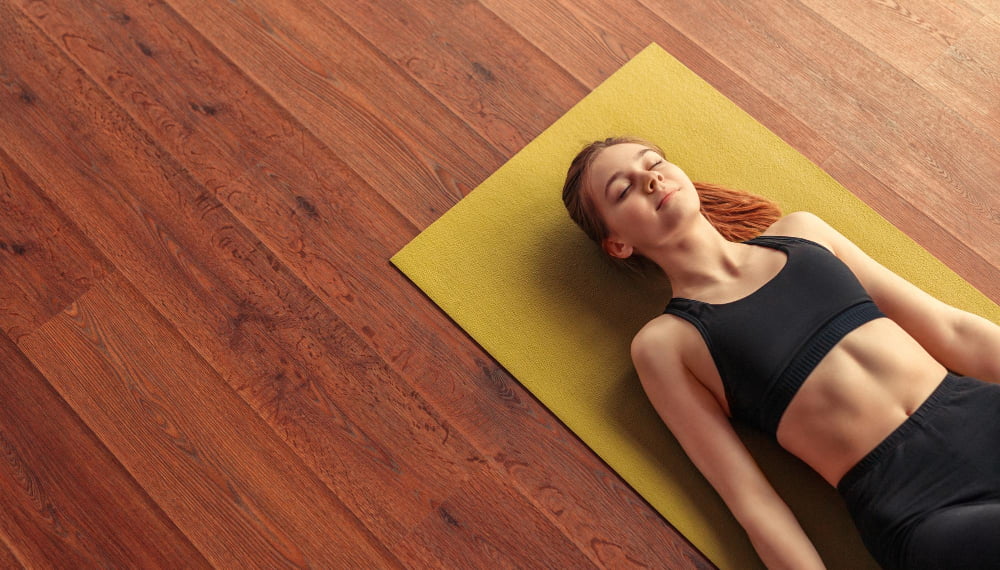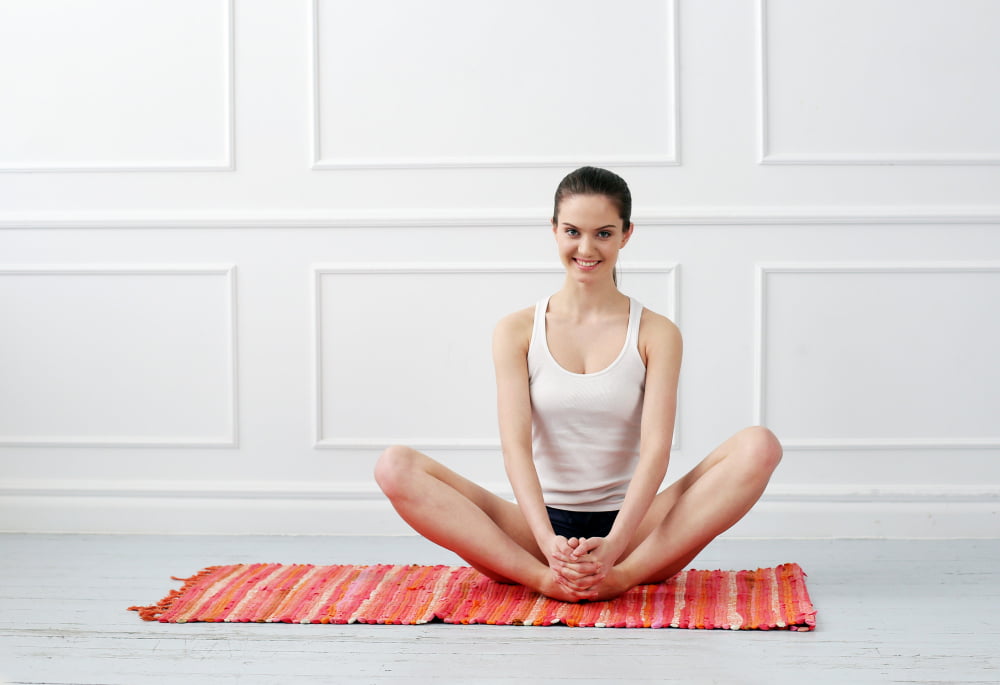Meditating daily enhances your overall well-being because it reduces stress, improves focus, and augments happiness, which is why learning to incorporate it into your routine can transform your life.
Incorporating meditation into your daily life can be a transformative experience, fostering a sense of calm, clarity, and overall wellbeing. The key is to make it a habit, integrating it seamlessly into your routine.
Start small, perhaps with a five-minute session each morning, gradually increasing the duration as your comfort and proficiency grow. Choose a quiet, comfortable spot where you won’t be disturbed, and use this time to focus on your breath, letting go of any thoughts that may arise.
As you progress, you may wish to explore different forms of meditation such as mindfulness or loving-kindness. Remember, the goal is not to empty your mind, but to present with your thoughts and feelings without judgement.
This article will guide you through these steps in detail, ensuring you have all the tools you need to make meditation a part of your everyday life.
Key takeaways:
- Start small and gradually increase meditation duration
- Explore different forms of meditation like mindfulness and loving-kindness
- Benefits include mental clarity, stress reduction, improved sleep, emotional health, and physical health
- Incorporate meditation into everyday activities like walking and mealtime
- Use guided meditations and apps for beginners to establish a regular practice.
Understanding the Basics of Meditation

Meditation is an ancient technique, designed to focus the mind and bring about a state of tranquility. It is not about emptying the mind but rather centering it, through concentration on a thought, word, or sensation. One of the crucial aspects of meditation is the posture—generally, it calls for sitting up straight, typically in a quiet, distraction-free environment.
There are countless types of meditation techniques, from focusing on breathing, visualizing imagery, to repeating a mantra. Despite the variety, all share a common goal: connecting with the present moment and fostering mindfulness—a mental state that involves being fully engaged in the present, aware of your surroundings, thoughts, and feelings without distraction or judgment.
Remember, meditation is not about achieving perfect serenity, but learning to observe without judgement, embracing thoughts as they come and go. As with any skill, it takes regular practice and patience to reap its many benefits.
Benefits of Daily Meditation

Incorporating meditation into daily life offers a plethora of advantages.
1. Enhances Mental Clarity and Focus: Regular meditation practice helps in honing concentration levels by training the mind to focus on one thing at a time, ultimately leading to improved performance in all life areas.
2. Alleviates Stress and Anxiety: By pacifying our nervous system, meditation allows us to decompress and relax, reducing stress hormone levels, and promoting an overall sense of well-being.
3. Boosts Self-awareness and Emotional Health: Meditation techniques like mindfulness encourage recognition of thoughts and behaviors, fostering personal growth and understanding. The practice also contributes to better emotional health by increasing positivity and reducing negative emotions.
4. Improves Sleep Quality: Through relaxation and stress reduction, meditation aids in combating insomnia, ultimately contributing to better quality sleep.
5. Augments Physical Health: Regular practice can help lower blood pressure, enhance immune function, and can even lessen symptoms in people with physical conditions aggravated by stress.
Through these points, it’s clear how daily practice can greatly improve mental, emotional, and physical health.
Incorporating Meditation Into Everyday Activities

Regular daily activities provide various opportunities for meditation. Commuting, for instance, can be transformed into a meditative moment by focusing the mind on the motion and rhythm of walking or driving. Applying mindfulness to these actions helps foster serenity amid routine tasks.
During mealtimes, chew food slowly, savoring its texture and flavor. This practice fosters the cultivation of gratitude while nourishing the body.
Household chores too can become mindfulness exercises. Engage fully with the process of cleaning, observing each action. Notice the water’s temperature on your hands, the smell of the cleaning products, the motion of sweeping.
Each of these everyday activities is an opportunity to engage with the present moment, cultivating a deeper connection with yourself and the world around you. Your focus turns inward, even amid outward tasks. Through these simple actions, each day becomes a meditation in motion, enhancing inner peace.
Practicing Guided Meditations for Beginners

Entering the realm of meditation can initially feel daunting. However, guided meditations offer an approachable method. Here, an experienced practitioner instructs you every step of the way, allowing you to immerse in the process without feeling lost or uncertain.
When selecting a guided meditation:
- Choose a quiet, comfortable space.
- Determine the length of your session.
- Select a guide whose voice and style align with your comfort.
- Allow yourself to be led but remain open to personal exploration.
Remember, it’s normal to experience distractions. Don’t become frustrated; instead, softly guide your attention back to your focal point, often the guide’s explanation. Apps like Headspace or Calm offer a variety of guided meditations, making this practice accessible no matter your location or availability. Begin with shorter sessions and gradually increase your mediation time as confidence and focus strengthen. Different styles exist—body scan, visualization, mindfulness—explore until you find the one which resonates deeply with you. These beginning steps will enable a seamless integration of meditation into your daily routine.
Employing Body Scan Meditation Technique

The Body Scan Meditation technique is a simple yet impactful practice that encourages being fully present with your entire body. Start by finding a comfortable position, either sitting or lying down, and close your eyes. Then, shift your attention to the soles of your feet, gradually moving upwards through every part of your body. Be aware of any tension, pain or discomfort you may feel.
Here’s how to practice effectively:
- Start at One End of Your Body: For instance, you can start by focusing your attention on the tips of your toes.
- Be Mindful of Each Body Part: Slowly extend your awareness through your feet, up your legs, through your abdomen, your arms, to the top of your head.
- Note Body Sensations: As you pay attention to each body part, notice any sensation, be it discomfort, warmth, tension or relaxation.
- Move Along at Your Own Pace: Don’t feel pressured to speed up or slow down. The goal isn’t to think about each body part but rather to experience it, as it is, in the present moment.
This practice isn’t about changing or fixing anything. It’s simply an opportunity to tune in, notice, and be present. With practice, you become more in tune with your body’s needs, creating a deep sense of inner tranquility.
The Practice of Walking Meditation

Walking meditation brings the serenity of mindfulness into physical activity. It’s a way to engage your body and mind simultaneously, fostering a deep awareness of your surroundings and inner thoughts.
Here’s a simple way to get started:
- Choose a quiet, uncluttered path: A peaceful environment promotes concentration and aids in reducing distractions.
- Begin walking slowly: Bring your attention to your steps. Feel your foot lift, move forward, and meet the ground.
- Synchronize breathing: Attempt to coordinate your breaths with your steps – inhale as you step with one foot, exhale with the other.
- Be mindful of your body: Pay attention to sensations in your body. Feel your muscles as they move, notice your posture, maintain a gentle gaze.
- Return focus when distracted: Your mind will likely wander. When you notice this, gently guide your attention back to your steps and breathing.
Walking meditation is not just about the destination, but the journey. It’s a practice of finding peace in motion and using mindfulness to transform a basic act into a method of self-awareness.
Introducing Loving-Kindness Meditation

This form of meditation, originating from Buddhist practices, encourages an uninhibited flow of love and kindness towards oneself and others.
1. Position: As with most meditations, choose a quiet space and sit comfortably, maintaining an upright posture.
2. Focus: Close your eyes, draw attention to your breath, allowing it to naturally relax your body and mind.
3. Affirmation: Begin to silently repeat phrases aimed at fostering a sense of self-compassion such as “May I be safe, may I be happy, may I be healthy, may I live at ease.”
4. Expand warmth: Gradually, shift focus from yourself to a loved one, repeating similar phrases like “May you be safe, may you be happy…”. Then extend this to neutral people, even to those you may have difficulties with.
5. Closure: Cap off the meditation by extending these positive affirmations to encompass all beings everywhere.
Implement this practice regularly, and it may have a profound impact, gradually transforming your mind-state, nurturing empathy, compassion, and unconditional love.
How to Establish a Daily Meditation Habit

To inculcate a regular meditation regimen, starting small is key, with just a few minutes each day. Once this becomes comfortable, gradually increase the duration.
It is essential to choose a consistent time and spot that promotes relaxation, reducing potential distractions. The morning, for example, can be perfect, setting a calm tone for the day ahead.
Using a dedicated app can also aid in maintaining regularity offering a variety of guided meditations to suit varying needs and moods.
Over time, the power of this habit formation not only reaps intrinsic benefits but also becomes a mindful refuge one looks forward to each day.
Remember, consistency far outweighs duration in these initial phases; it’s about creating a habit that eventually becomes a non-negotiable part of your routine, offering a haven of serenity amidst the hustle of daily life.
FAQ
How do I have a meditation lifestyle?
To cultivate a meditation lifestyle, strive for consistency by committing to meditate every day to ensure maximum benefits for your mind and body.
What happens when you start meditating everyday?
When you start meditating every day, you experience lower levels of physical and emotional stress, enhanced sleep quality, and increased pain tolerance.
What are the best techniques for beginners to start a daily meditation practice?
Beginners to meditation can start their daily practice using basic techniques such as observing the breath, practicing mindfulness, employing guided meditations, setting a regular schedule, and ensuring a quiet and comfortable meditation space.
How can someone stay consistent with their meditation routine?
To stay consistent with your meditation routine, you should set a specific time each day, start with manageable sessions, gradually increase your meditation time, integrate it into your daily routine, and use guided meditation apps to help stick to your practice.
What impact can regular meditation have on mental and physical health?
Regular meditation can significantly reduce stress, improve concentration, boost overall happiness, and enhance physical well-being by positively impacting blood pressure and heart health.